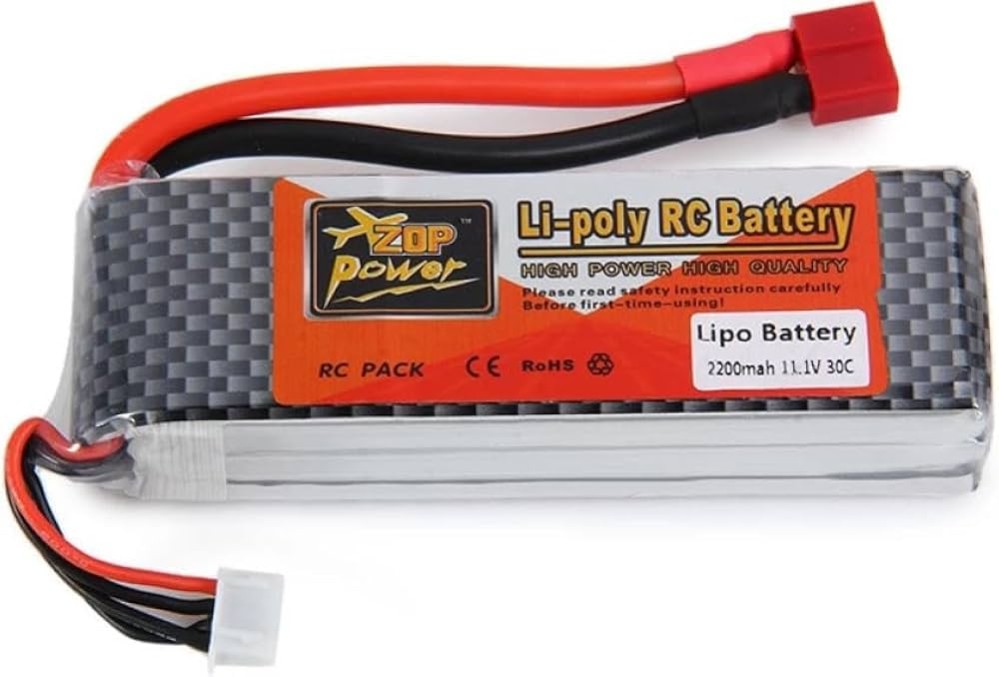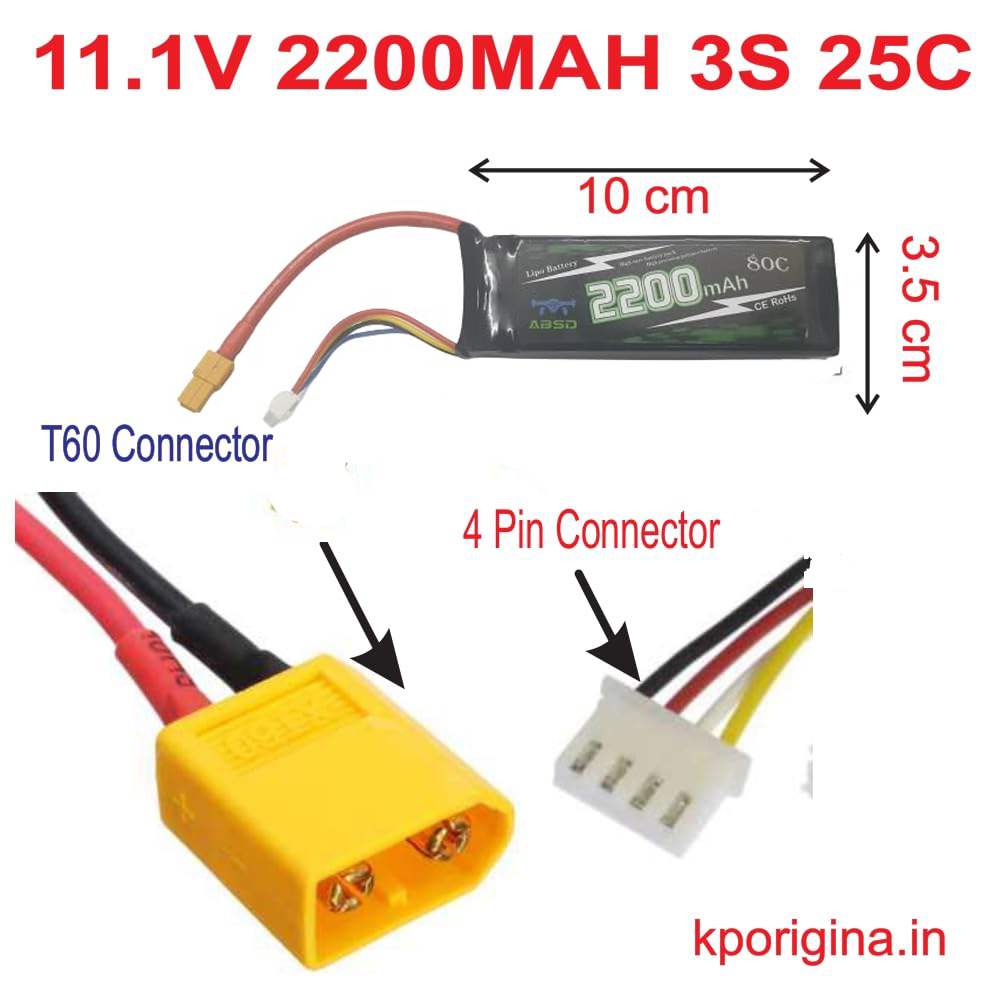








LIPO 11.1V 2200mAh drone battery
The 11.1V 2200mAh 3S 25C LiPo battery with an XT60 plug is a compact and lightweight power source suitable for a wide range of applications, including RC aircraft, drones, cars, boats, and other devices that require a reliable and high-capacity battery.
₹ 1,829 ₹2,200
2,200



| Made In : | India |
Add FAQ
The 11.1V 2200mAh LiPo (Lithium Polymer) battery is a commonly used power source for medium-sized drones, especially those used for FPV (First Person View), aerial photography, or hobby drones. The 11.1V indicates the voltage of the battery, and the 2200mAh denotes the capacity of the battery. This combination makes the 11.1V 2200mAh LiPo battery suitable for providing adequate power while offering longer flight times than smaller batteries.
Key Specifications of the 11.1V 2200mAh LiPo Battery:
-
Voltage (11.1V):
- The 11.1V voltage refers to a 3-cell (3S) LiPo battery configuration. Each cell in a LiPo battery has a nominal voltage of around 3.7V, and a fully charged cell reaches 4.2V, which totals 11.1V for a 3-cell (3S) setup.
- This voltage is common for drones with medium-sized motors and allows for a good balance of power output and flight time.
-
Capacity (2200mAh):
- 2200mAh (milliamp-hours) is the capacity of the battery, indicating how much charge the battery can store. It directly affects flight time: the higher the capacity, the longer the flight time, assuming the drone is not too heavy and its power consumption remains stable.
- For example, a 2200mAh battery can theoretically supply 2200mA (2.2A) for 1 hour. In practice, however, drones usually consume more power, so flight times are typically between 15 to 30 minutes, depending on factors such as the drone’s weight, motor power, and flight conditions.
-
Discharge Rate (C Rating):
- The C rating indicates the maximum safe discharge rate of the battery. A typical LiPo battery will have a C rating such as 25C, 30C, or 40C.
- For example, a 25C rating means the battery can safely supply 25 times its capacity as a discharge current. For a 2200mAh battery, a 25C rating would allow a maximum current of 55A (2200mAh * 25 = 55,000mA or 55A).
- A higher C rating provides more power on demand, which is particularly useful for high-performance drones, racing drones, or those requiring sudden bursts of power.
-
Weight and Size:
- An 11.1V 2200mAh LiPo battery typically weighs between 150g to 250g, depending on the manufacturer and the materials used.
- It's essential to ensure that the weight of the battery is within the drone’s payload capacity to avoid negatively affecting flight performance.
-
Charging Voltage:
- The charging voltage for a 3S LiPo battery (11.1V) is typically 12.6V (4.2V per cell x 3 cells). It’s crucial to use a LiPo-compatible charger designed for 3S batteries to safely charge the battery.
- Overcharging or undercharging LiPo batteries can damage them and create safety risks such as fire or explosion.
-
Battery Life:
- LiPo batteries have a typical life cycle of 200-300 charge/discharge cycles before their capacity starts to degrade significantly. Proper care, such as not overcharging, storing the battery at around 50% charge for long-term storage, and avoiding deep discharges, can extend the lifespan of the battery.
Advantages of the 11.1V 2200mAh LiPo Battery:
-
Powerful and Efficient:
- With a 3S configuration (11.1V), the battery provides the necessary voltage to power medium-sized motors effectively, offering a good balance of thrust and efficiency.
-
Longer Flight Times:
- The 2200mAh capacity is enough to provide a decent flight time for many drone models, typically between 15-30 minutes depending on the drone’s weight and power consumption.
-
Compact and Lightweight:
- Despite offering 2200mAh of capacity, these batteries are relatively compact and lightweight, making them suitable for medium-sized drones that require a balance of power and flight time without adding excessive weight.
-
Widely Compatible:
- 11.1V 2200mAh LiPo batteries are widely used in the drone industry, making them easily available and compatible with a wide range of hobby drones.
-
Higher Power Output:
- With the right C rating, the battery can deliver high current to support heavy-duty tasks, such as carrying a camera or other payloads, or when quick bursts of power are required during aggressive maneuvers.
Disadvantages/Considerations:
-
Safety Concerns:
- LiPo batteries are sensitive to overcharging, deep discharges, and physical damage. If not properly handled, LiPo batteries can catch fire or explode.
- Always use a LiPo-safe charging bag and follow manufacturer guidelines for charging, discharging, and storing.
-
Battery Maintenance:
- LiPo batteries require specific maintenance practices to prolong their life, such as balancing the cells and ensuring they are not left fully charged or fully discharged for long periods.
- Storing the battery at around 50% charge when not in use for long periods helps maintain battery health.
-
Limited Flight Time:
- While 2200mAh offers a good balance of flight time, heavier drones or those with high power demands (e.g., FPV drones, high-performance drones, or drones carrying heavy payloads) may experience shorter flight times. For longer flight times, consider higher-capacity batteries (e.g., 3000mAh, 5000mAh, etc.).
Applications of the 11.1V 2200mAh LiPo Battery:
-
Medium-Sized Drones:
- This battery is commonly used in medium-sized drones or quadcopters that require a 3S LiPo battery. These drones can be used for FPV racing, aerial photography, or freestyle flying.
-
RC Planes and Helicopters:
- It can also be used for RC planes, helicopters, and other hobbyist remote-controlled vehicles that require a balance of power and endurance.
-
DIY Projects:
- For drone enthusiasts or hobbyists building custom drones or other projects, this battery is a good choice for powering flight controllers, motors, and additional equipment.
How to Properly Charge and Care for a LiPo 11.1V 2200mAh Battery:
-
Use a Proper LiPo Charger:
- Ensure you use a charger that is specifically designed for LiPo batteries and supports 3S charging (i.e., charges the battery to 12.6V).
-
Monitor Battery Voltage:
- Avoid discharging the battery below 3.0V per cell (or 9.0V for a 3S battery). If a LiPo battery is discharged too low, it can be permanently damaged.
-
Store Safely:
- If you’re not using the battery for an extended period, store it at 50% charge (around 11.4V for a 3S battery) to preserve its health.
- Store the battery in a cool, dry place, and preferably in a LiPo-safe bag to mitigate any fire risk in case of a malfunction.
-
Monitor Temperature:
- While charging or using the battery, check the temperature. If the battery becomes too hot (above 60°C or 140°F), it may indicate a problem, and you should stop using or charging it.
Conclusion:
The 11.1V 2200mAh LiPo battery is a versatile and widely used power source for medium-sized drones, offering a good balance of power and flight time. It is ideal for hobby drones, FPV racing, and aerial photography drones. However, it requires proper care, including safe charging, discharging, and storage practices, to ensure long-term reliability and safety. If you are flying drones, ensure that the battery’s specifications (voltage, capacity, and discharge rate) match the power requirements of your drone's motor and ESC (electronic speed controller) for optimal performance.

0 Reviews For this Product



.jpg&width=225&quality=80)






